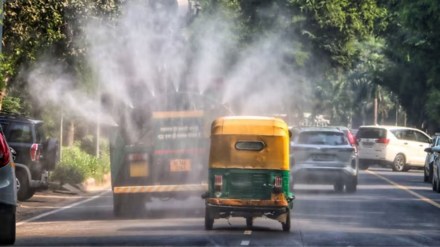A report by the Comptroller and Auditor General (CAG) tabled in the Delhi Assembly has highlighted serious lapses in the city’s pollution control mechanisms. The report points to irregularities in issuing Pollution Under Control (PUC) certificates, unreliable air quality monitoring systems, and weak enforcement of pollution control measures as key contributors to Delhi’s worsening air pollution crisis.
The report, titled ‘Vehicular Air Pollution in Delhi’, was presented by Chief Minister Rekha Gupta and underscores major policy gaps, weak enforcement, and poor coordination among agencies as the primary reasons for the deteriorating air quality.
The previous Aam Aadmi Party (AAP) government came under criticism in the report for not conducting real-time studies to identify pollution sources, an essential step for implementing targeted solutions. “Vehicles are one of the major local contributors to Delhi’s poor air quality,” the report stated.
Lapses in Delhi’s pollution control measures – Key findings
1. It reveals that over 1.08 lakh vehicles received PUC certificates despite emitting carbon monoxide (CO) and hydrocarbons (HC) beyond permissible limits. Additionally, in many instances, multiple vehicles were issued PUC certificates within a minute of each other, raising concerns over the credibility of the certification process.
2. Between 2015 and 2020, nearly 4,000 diesel vehicles that exceeded pollution limits were wrongly certified as compliant, allowing them to remain on the road despite high emissions.
3. The report also highlights the failure of Delhi’s Continuous Ambient Air Quality Monitoring Stations (CAAQMS) to meet the standards set by the Central Pollution Control Board (CPCB), leading to inaccuracies in pollution control data. Consequently, the Air Quality Index (AQI) values reported daily may not always reflect actual pollution levels, making it difficult for authorities to take appropriate action.
4. Another key concern raised in the report is the failure to deregister overage vehicles. Out of the 47.51 lakh end-of-life vehicles (ELVs) that were required to be deregistered between 2018-19 and 2020-21, only 2.98 lakh (6.27 per cent) were removed from records, while the remaining 93.73 per cent (44.53 lakh vehicles) still had active registration status as of March 2021.
5. Additionally, none of the 347 impounded vehicles were scrapped by March 2021 due to inadequate impounding space, which can accommodate only 4,000 vehicles, far below the 41 lakh vehicles awaiting scrapping.
6. The CAG report also highlighted inadequate enforcement due to staff shortages and a lack of pollution-checking equipment. The transport department’s enforcement teams lacked vehicles equipped with PUC testing devices, making it difficult to monitor violations effectively. Furthermore, entry points to the city lacked proper monitoring, exposing weaknesses in enforcement efforts.
7. A significant failure identified in the report is the non-compliance with Supreme Court orders from 1998 regarding the development of two Inter-State Bus Terminals (ISBTs) at Delhi’s southwest and north entry points. These terminals were meant to prevent diesel-powered inter-state buses from entering the city’s core. Despite over two decades passing, the Delhi government has not established the ISBTs at Dwarka and Narela. As a result, diesel-operated inter-state buses continue to travel through the city to reach existing ISBTs at Sarai Kale Khan and Kashmere Gate, adding to vehicular pollution.
8. Concerns were also raised about the mismanagement of funds meant for improving parking infrastructure. Although taxes were collected for parking facilities, there were no official records detailing how these funds were utilised. Poorly managed parking spaces contribute to congestion and increased vehicular emissions, further aggravating Delhi’s air pollution problem.
9. Despite multiple government interventions and action plans, the CAG report attributes Delhi’s pollution crisis not just to external factors such as stubble burning in neighboring states but also to systemic failures within the city’s own regulatory framework.
10. The report highlights vehicular emissions, industrial pollution, construction dust, and improper waste disposal as major contributors to the worsening air quality. The report calls for stricter pollution control measures, better monitoring systems, and increased public awareness to address the crisis effectively.
